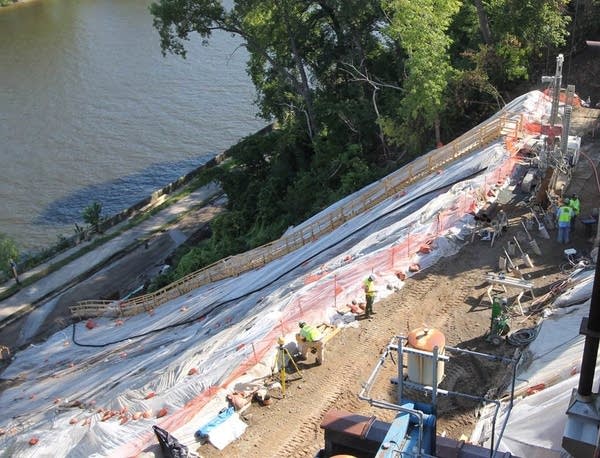Minneapolis' West River Parkway reopening after mudslide

Go Deeper.
Create an account or log in to save stories.
Like this?
Thanks for liking this story! We have added it to a list of your favorite stories.
A well-traveled section of the West River Parkway in Minneapolis reopens Thursday after being closed for more than two years.
In June 2014, torrential rains triggered a mudslide that buried a section of the road and bike path.
Restoring access to the parkway was a major undertaking, park board officials said.

Cliff Swenson, director of the park board's Design and Construction Management Division, said workers had to remove several thousand yards of soil and debris from the site before they could figure out how to make the area safe again.
Turn Up Your Support
MPR News helps you turn down the noise and build shared understanding. Turn up your support for this public resource and keep trusted journalism accessible to all.
The first retaining wall was built at the top of the slope directly underneath the University of Minnesota's Fairview Medical Center campus, he said.
"You had a contractor working at about 100 feet-plus above the parkway on a slope that continued to move that continued to have mini-slides, if you will," said Swenson. "They had to have equipment and personnel up there."
Swenson said the slope was still unstable because groundwater continued to seep through the area.

Mike Haggerty, senior geo-technical engineer for Barr Engineering, said workers had to secure the first wall with piles that burrow into the limestone.
"The reason that one had to be constructed first — or desirable to have that one constructed first — is we needed to insure safety, not only during construction for the workers but the existing structures up on the top of the hill," Haggerty said.
In addition to the retaining walls, Swenson said other features are built in to prevent future mudslides. He said workers installed a system designed to keep rainwater runoff from the Fairview buildings from seeping into the groundwater. And Swenson said much of the original soil was replaced with more structurally stable soil. New trees and shrubs, which will help reduce erosion, will be planted there this fall.
The project cost $5.6 million. Park board officials say the Federal Emergency Management Agency, or FEMA, is expected to pay 75 percent of construction costs and the state will cover the rest.


